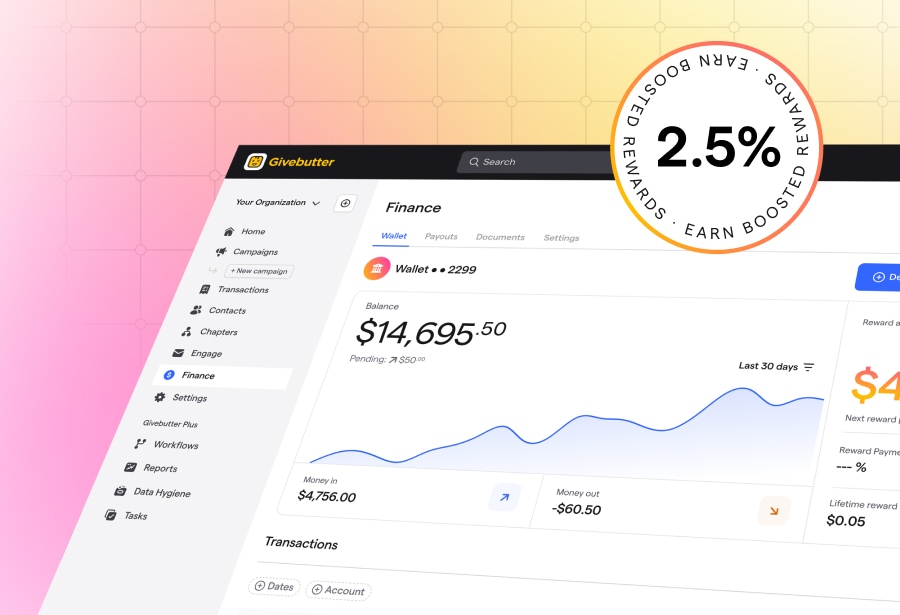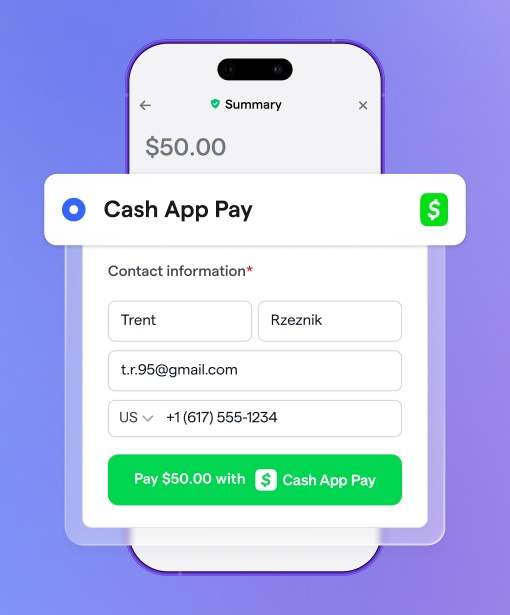Table of contents
Table of contents
GoFundMe is one of the most recognized fundraising platforms worldwide, offering options for individuals, teams, and nonprofits. Its tools make it easy to launch campaigns quickly and reach wide audiences. In addition to its main platform for personal fundraising, GoFundMe Pro (formerly Classy) provides a more advanced solution for nonprofit organizations with customizable donation forms, event management, and CRM integrations.
Depending on your organization’s goals, however, you may want to explore other fundraising platforms that emphasize different strengths—such as community engagement, donor experience, or pricing flexibility.
To help you find the best fit, we’ve compared six strong GoFundMe alternatives for nonprofits and mission-driven teams.
The best GoFundMe alternatives at a glance
Looking for a platform that better fits your fundraising needs? Here are six strong alternatives to GoFundMe worth considering, including:
1. Givebutter: One place to raise funds, host events, and engage supporters
2. Kickstarter: Fast-track fundraising for creative projects
3. Fundly: Simple fundraising pages for any cause
4. Indiegogo: Crowdfunding for entrepreneurs and innovators
5. Bonfire: Custom merch for your cause
6. Patreon: Membership-based fundraising for creators and nonprofits
With so many fundraising platforms out there, how do these stack up? Keep reading to compare their fees, features, and why users rate them as better than GoFundMe.
1. Givebutter: One place to raise funds, host events, and engage supporters

💰 Price: Givebutter’s core fundraising features are free to use when you enable optional donor tips—your nonprofit pays $0 thanks to the Givebutter Guarantee. If you disable tips, a flat 3% platform fee applies across all campaign types, plus standard processing fees that you can choose to pass on to donors, make optional, or cover yourself.
✅ Best for: Nonprofits, schools, faith-based groups, and any organization looking for a comprehensive fundraising platform with events, auctions, and marketing and engagement tools.
👉 Our take: Givebutter is a free, end-to-end platform with 160+ features and integrations, including fully customizable fundraising pages, embeddable donation forms, and livestreaming. It also supports multiple payment options, including Cash App, Venmo, Apple Pay, Google Pay, cash, check, credit and debit cards, and even text-to-donate—just to name a few. 😉
Add on its robust donor management (CRM) tools, and Givebutter isn’t just an alternative—it’s an upgrade.
What users like about Givebutter
Givebutter has so many amazing features. It has been completely thought out by its team. It’s clearly designed with nonprofits in mind. And if you need help, their customer service is quick to respond and always has the answers you need. Givebutter is a WYSIWYG system. It’s so simple to use and navigate. — Givebutter review, William W.
What users dislike about Givebutter
There is a community of most-requested items/features to add that Givebutter is actively working on. Our nonprofit would have happily paid for those options if they were available, considering how much was already free. — Givebutter review, Dani T.

Switch today, raise more tomorrow
2. Kickstarter: Fast-track fundraising for creative projects

💰 Price: Kickstarter’s fees total 8% + 20 cents per transaction, making it one of the more expensive crowdfunding platforms.
✅ Best for: Users fundraising for a concrete creative work or experience, such as films, books, food ventures, games, tech gadgets, and other artistic endeavors. While nonprofits and other groups can use Kickstarter, they can only do so to produce a new and shareable project—not for general fundraising, charity, personal needs, or advocacy efforts.
👉 Our take: Kickstarter puts creators on the fast track to their fundraising goal by allowing them to build a compelling campaign page, set a funding target, and offer their backers meaningful rewards for their contributions. Once an idea is screened and approved, backers pay via credit card and can follow progress updates on the project page.
One key caveat: a Kickstarter campaign is all or nothing. You must raise (or exceed) your fundraising goal, or you won’t receive any money. While this high-stakes approach might be motivating for some users, it could be a dealbreaker for individuals or nonprofits in need of critical project revenue.
What users like about Kickstarter
What is most helpful about Kickstarter is that it helps the ideas and projects of people come to reality through the funds they receive. — Kickstarter review, Joel A.
What users dislike about Kickstarter
The cost that we have to incur for transaction fees is somewhat on the high end when it comes to creative crowd funding websites. — Kickstarter review, Emery D.
3. Fundly: Simple fundraising pages for any cause

💰 Price: Fundly’s costs edge out even Kickstarter's, at roughly 8% + 30 cents per transaction when factoring in platform and processing fees.
✅ Best for: Fundly allows anyone to create a personalized fundraising page. Causes can range from personal medical bills and creative projects to political projects to annual fundraisers for clubs and sports teams.
👉 Our take: Fundly’s high costs aren’t necessarily reflected in the product. Donation pages are plain and transactional, and there’s no mobile app available in the App Store or Google Play Store. That said, you can enhance your campaign with photos, videos, and an engaging description of your cause. Once your page is created, you get access to basic email sending features and social network sharing to promote your campaign.
Fundly does offer some cost-saving flexibility by letting you keep all the money you raise regardless of your goal status. You can also incentivize giving with special contribution levels and Fundly’s built-in merchandise creator.
What users like about Fundly
It is very easy to set up a fundraiser and share it with a lot of people. A lot of useful tools are available on the website, and the customer support is really good. — Fundly review, Veronica F.
What users dislike about Fundly
There is quite a learning curve getting the software to do what you'd like it to do when it comes to running reports and creating communications. — Fundly review, Mindelei W.
4. Indiegogo: Crowdfunding for entrepreneurs and innovators

💰 Price: Indiegogo’s fees are on par with Kickstarter and Fundly, totaling a high 8% + 30 cents per transaction.
✅ Best for: Individuals and organizations funding creative projects and launching fundraising or product campaigns.
👉 Our take: Indiegogo was launched in 2007 as one of the first crowdfunding websites and it’s still providing a flexible way to raise funds. The platform also offers campaign success tools, like pre-launch support, ongoing promotion programs, and distribution help. With a hybrid of the keep-it-all campaign and the all-or-nothing campaign, you get to control your experience. And where most fundraising sites only take credit cards, Indiegogo takes credit and debit cards, Apple Pay, and Google Pay. That addition automatically widens your audience of potential backers.
There are some restrictions to keep in mind: Indiegogo cannot be used for personal causes, such as medical expenses, travel, and disaster relief.
What users like about Indiegogo
It's easy to navigate the website and sign up, and it's also easy to find great campaigns. You can get updated about the campaign's progress as often as you want and also get emailed about new additions. Basically, there is nothing to complain about the service at all, if it is an honest campaign. — Indiegogo review, Sven B.
What users dislike about Indiegogo
Indiegogo makes money off fraudulent campaigns, intentionally allowing these people to copy-paste new campaigns, gather money, and not fulfill their obligations to the customer. — Indiegogo review, Ben T.
5. Bonfire: Custom merch for your cause

💰 Price: Free to create an account. On top of your product sales, you can enable fundraising, but there’s an 8% per-transaction fee for these tips and donations. Fees for verified nonprofits are lowered to 3.5%.
✅ Best for: Groups looking to raise funds by selling custom-designed merchandise like t-shirts or setting up a full online merchandise store.
👉 Our take: If you’ve participated in a t-shirt fundraising campaign, you know how easy and cost-effective they can be. Bonfire turned the classic t-shirt campaign into a crowdfunding site. All funds raised go directly to the seller, while Bonfire handles product distribution after the campaign ends.
Although it’s user-friendly, Bonfire lacks some essential tools. It doesn’t include in-house email, social media, or SMS and, critically, doesn’t provide donor information. Additionally, Bonfire doesn’t issue individual donor receipts, so you miss out on an important opportunity to personally thank each supporter. These limitations could be a drawback for nonprofits that prioritize donor engagement opportunities.
What users like about Bonfire
I love that it is very easy to create merchandise to sell on this website. It is very useful to be able to print your designs and make tees and other merch. I love that I can make tees of my own art with Bonfire. — Bonfire review, Marie-Claire P.
What users dislike about Bonfire
I didn't like the process to collect money for your sold designs. As someone with a Middle East bank account, it’s a bit hard to find a way to receive your money. — Bonfire review, Odai A.
6. Patreon: Membership-based fundraising for creators and nonprofits

💰 Price: Patreon's platform fee can run between 5-12% of your monthly income on the site. Plus, standard payment processing fees are 2.9% + 30 cents per transaction (for payments over $3) or 5% + 10 cents per transaction (for payments under $3). A payout fee of 25 cents or 1% per transfer to your bank account also applies.
✅ Best for: Creators and organizations looking to build steady, recurring revenue through patron-based memberships.
👉 Our take: Patreon proves that fandom is a powerful force for raising money. While it’s best known for helping YouTube and podcast creators monetize their content, it’s also an option for nonprofits looking to grow recurring donations. Users can set up monthly membership tiers, offering different pledge levels for access to exclusive content and other perks. For the most part, it’s a win-win. Creators produce the content they care about, and supporters can take pride in supporting a cause they care about while receiving special perks.
However, Patreon’s fee structure takes a sizable cut of monthly earnings on top of credit card and payout fees. Nonprofits should carefully weigh these costs before committing.
What users like about Patreon
Patreon is easy to use. It has payment options that are available in my country. — Patreon review, Sharon B.
What users dislike about Patreon
I don't love the comment system on Patreon—I feel like I miss things sometimes. It's really like posting on a blog as opposed to something more social media-like. — Patreon review, Brittany W.
How GoFundMe alternatives stack up
Done correctly, a crowdfunding campaign can rally hundreds—or even thousands—of supporters. No matter the cause, the potential to make a big impact is huge—and it all starts with the right platform.
The platforms we’ve discussed each offer unique features, but Givebutter is the only GoFundMe alternative for individuals and nonprofits that provides an all-in-one fundraising solution designed for long-term success.
Sign up for your free account today to see why more and more nonprofits are choosing Givebutter over fundraising sites like GoFundMe.
FAQs: Top questions on GoFundMe alternatives
Is there a better option than GoFundMe?
That depends on your goals. GoFundMe offers both a main platform for personal and team fundraisers and GoFundMe Pro (formerly Classy) for nonprofits seeking advanced features like events, recurring giving, and CRM integrations.
If you’re looking for a platform built specifically for nonprofits—with built-in donor management, event tools, and engagement features—Givebutter may be a better fit. It combines everything in one place, with transparent, predictable pricing.
Is there a GoFundMe alternative without fees? / Are there free GoFundMe alternatives?
Yes. Givebutter offers no platform or processing fees backed by the Givebutter Guarantee. That means nonprofits receive 100% of every donation—no hidden costs or required subscriptions.
By comparison, GoFundMe’s main platform has no platform fees but charges standard payment processing fees (2.9% + 30¢ per donation). GoFundMe Pro (formerly Classy) offers nonprofit-specific features and flexible fee structures, but pricing is custom and available only through a demo or contract.
Is Givebutter better than GoFundMe?
Each platform serves different audiences. GoFundMe is ideal for personal and short-term fundraising campaigns, while GoFundMe Pro provides robust tools for nonprofits through customized plans.
Givebutter offers a free, all-in-one fundraising platform with no platform or processing fees—combining donations, events, CRM, and engagement tools in one free platform from day one.
👉 Compare Givebutter and GoFundMe side by side →
How much does GoFundMe take on a $100 donation?
On GoFundMe’s main platform, a $100 donation incurs standard processing fees of 2.9% + 30¢ (about $3.20). For GoFundMe Pro, fees vary based on contract terms and selected features.
Givebutter, under the Givebutter Guarantee, passes 100% of each donation to your organization.
This web page is not endorsed by, affiliated with, maintained, authorized, or sponsored by GoFundMe, Inc. All company names, product names, trademarks, and other images featured or appearing herein are the property of their respective trademark owners.
.svg)






%20(1).png)












.webp)




